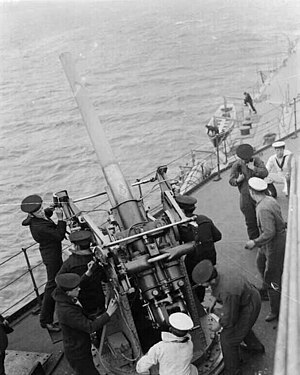| QF 3 inch 20 cwt anti-aircraft gun | |
|---|---|
 Aboard HMS Royal Oak in World War I | |
| Type | Anti-aircraft gun |
| Place of origin | United Kingdom |
| Service history | |
| In service | 1914–1947[1] |
| Used by | United Kingdom Australia Canada Finland Ireland |
| Wars | World War I World War II |
| Production history | |
| Designer | Vickers |
| Variants | Mk I, Mk I*, Mk IB, Mk 1C, Mk 1C*, Mk IE, Mk SIE, Mk II, Mk III, Mk IV, Mk IVA[2] |
| Specifications | |
| Mass | 2,240 lb (1,020 kg), gun and breech 5.99 tons,[3] with 2-wheel platform |
| Barrel length | Bore: 11 ft 4 in (3.45 m) (45 cal) Total: 11 ft 9 in (3.58 m)[3] |
| Crew | 11[4] |
| Shell | Fixed QF HE 76.2 × 420 mm R[5][6] |
| Shell weight | 12.5 lb (5.7 kg), 1914; 16 lb (7.3 kg), 1916 |
| Calibre | 3 inches (76 mm) |
| Breech | Semi-automatic sliding-block[7] |
| Recoil | 11 inches (280 mm). hydro spring, constant[3] |
| Carriage | High-angle wheeled, static, or lorry mounting |
| Elevation | −10 – 90°[3] |
| Traverse | 360° |
| Rate of fire | 16–18 rpm[8] |
| Muzzle velocity | 2,500 ft/s (760 m/s), 12.5 lb (5.7 kg) shell 2,000 ft/s (610 m/s), 16 lb (7.3 kg) shell[9] |
| Effective firing range | 16,000 ft (4,900 m)[8] |
| Maximum firing range | 23,500 ft (7,200 m), 12.5 lb shell[3] 22,000 ft (6,700 m), 16 lb shell[8] |
The QF 3-inch 20 cwt anti-aircraft gun became the standard anti-aircraft gun used in the home defence of the United Kingdom against German Zeppelins airships and bombers and on the Western Front in World War I. It was also common on British warships in World War I and submarines in World War II. 20 cwt referred to the weight of the barrel and breech, to differentiate it from other 3-inch guns (1 cwt = 1 hundredweight = 112 lb, 51 kg, hence the barrel and breech together weighed 2,240 lb, 1,020 kg). While other AA guns also had a bore of 3 inches (76 mm), the term 3-inch was only ever used to identify this gun in the World War I era, and hence this is what writers are usually referring to by 3-inch AA gun.
- ^ Hogg & Thurston 1972, page 78
- ^ Campbell, Naval Weapons of WWII, p.61-62.
- ^ a b c d e Hogg & Thurston 1972, page 79
- ^ Farndale 1988, page 397
- ^ Routledge 1994, page 9, 13
- ^ "77-77 MM CALIBRE CARTRIDGES". www.quarryhs.co.uk. Archived from the original on 17 January 2015. Retrieved 12 September 2017.
- ^ Routledge 1994, page 12
- ^ a b c Routledge 1994, page 13
- ^ Routledge 1994, page 9